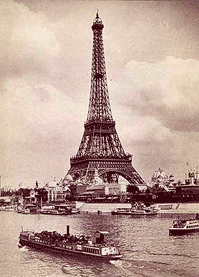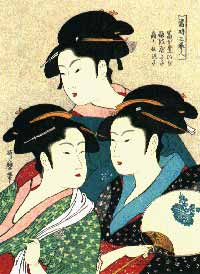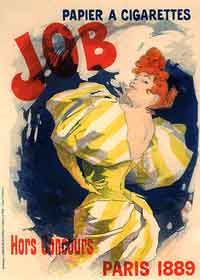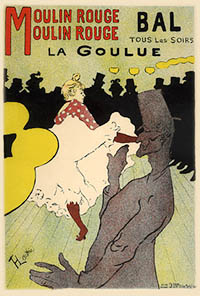| Paris & The Belle Epoque Poster Craze | |||
 |
 |
 |
 |
| The Belle Époque 1880–1914
In industrialized nations the Industrial Revolution created a new middle class, one with a surplus of leisure time and expendable income. In France this economic growth coincided with a period of peace and frivolity known as the Belle Époque (Beautiful Era). An important visual element of the Belle Epoque, especially in Paris, was the lithographic poster. Although first used to market goods and theatrical entertainment, the poster transformed into a collectable and affordable work of art for middle class homes. This was a golden era of illustration and graphic design. The large format of posters allowed designers to make a commanding public presentation and illustrator's names were popularly recognized. Typefaces were derived from unique lettering designed to compliment illustrations. Posters were the main vehicle for advertising prior to the magazine era. Unfortunately the public also became conditioned to the images of young women, often in partial dress, used as shills for product advertising. 1
|
The Ukiyo-e Influence
In the 1850's Japan's borders opened for the first time since 1637, partly due to pressure applied by US Admiral Matthew Perry. Ukiyo-e prints were exported to the west and influenced painters and graphic artists including Degas, Van Gogh and Henri Toulouse-Lautrec. Ukiyo-e paintings incorporated traditional elements of emaki (picture scrolls) and decorative designs. The term Ukiyo-e translates as pictures of the floating world, a reference to the theater and tea house districts of Tokyo. Ukiyo-e wood block posters were used to advertise theatrical performances, brothels, popular actors and beautiful teahouse girls. The earliest Ukiyo-e prints were spare black and white line prints, sometimes hand-colored. Later Ukiyo-e artists and book illustrators created rich colors using multi-block printing processes. Ukiyo-e characteristics embraced by Europeans and expressed in their poster art:
|
Jules Cheret 1836–1932
In chromolithography (color lithography) each color had to be printed separately, requiring careful registration. Jules Cheret revamped the process by developing his famous three stone process, which allowed printers to achieve every color in the rainbow with as little as three separate lithographic stones—primarily using red, yellow and blue transparent inks. When the transparent inks overlapped a new color was created. In time the large and heavy stones were replaced with the much easier to handle zinc plates. Cheret's subject matter dealt mainly with the gaieties of Parisian night life in theatres and cafes. His posters sold not only products but an image—the image of the ideal life and the ideal woman. Although probably not a novel concept, Cheret's use of pretty young women to advertise retail products was widely copied. His fantasized provocative beauties, dubbed "Chèrettes," (often 8 feet tall) were an unhealthy first step towards media promoting impossible body types for women.
|
The Maîtres de l'Affiche
Reputable artists were willing to design posters due to the medium's growing prestige. These artistic prints were so popular that they were stolen off of walls almost as soon as they were hung. Cheret organized the first group exhibition of posters in 1884 and two years later published the first book on poster art. He further capitalized on the public interest by arranging for 97 artists to create posters, at a reduced size of approximately 11 x 15 inches, that were suitable for in-home display. Working with the print house, Chaix, the enterprise was marketed from 1890–1900 under the name "Maîtres de l'Affiche" (Masters of the Poster). Serial editions, each containing five prints, were sold to advance subscribers. With advance funding assured, the posters were printed on high quality paper, not the cheap stock used for temporary outdoor display posters. Some participating artists included Toulouse-Lautrec, Denis, Bonnard, Mucha, Steinlen, Beggarstaffs, Grasset, Penfield, Parrish and Bradley. Collectors can still find these prints for sale today.
|
| Footnotes | |||
| 1 Gustave Eiffel's (1832-1923) tower was built for the Paris Exposition of 1889 at the height of the Belle Époque. |
|||
| Copyrights | |||
| ©Designhistory.org 2011 | For Permission Info click here | ||
